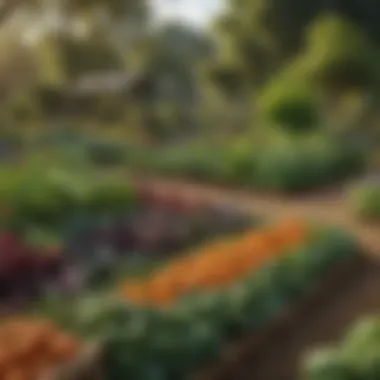Understanding Heirloom Seeds: Definitions and Implications


Intro
Heirloom seeds represent a vital component in the framework of sustainable agriculture. With their rich history and unique qualities, they serve not only as a means of cultivation but also as a bridge to ecological diversity. Understanding these seeds is essential for farmers, gardening enthusiasts, and anyone interested in food sovereignty. This exploration will dive into the multifaceted nature of heirloom seeds, their definitions, and the implications of their use in today's agricultural landscape.
Topic Overview
Definition of Key Terms
Heirloom seeds are defined as seeds that have been passed down through generations, typically for at least 50 years. They are open-pollinated, which means they can reproduce themselves and maintain desirable traits over time. This distinguishes them from hybrid seeds, which often exhibit variability in their offspring and require farmers to purchase new seeds each planting season.
Relevance in Agriculture, Horticulture, and Agronomy
In agriculture, heirloom seeds play a significant role in promoting biodiversity. Biodiversity is crucial for resilience in ecosystems where monoculture practices dominate. Farmers who adopt heirloom varieties can contribute to ecological stability while also preserving cultural heritage tied to specific plant varieties. Also, these seeds often showcase unique flavors and nutritional profiles that are often absent in commercial varieties.
Current Trends and Innovations
Recent Advancements in the Field
The rise in sustainable farming practices has stimulated renewed interest in heirloom seeds. Farmers markets and community-supported agriculture programs often highlight these varieties, bringing them into the spotlight. This is necessary for revitalizing local economies and providing consumers with fresh, diverse produce.
Emerging Technologies and Practices
Advanced techniques in seed preservation and propagation are emerging. Many organizations focus on cataloging and preserving heirloom varieties. This practice safeguards genetic diversity and ensures that these seeds remain available for future generations. Organizations like Seed Savers Exchange are crucial in these efforts. These advancements ensure a sustainable farming future with increased resilience
Practical Applications
Step-by-Step Guides or How-Tos
- Research Local Heirloom Varieties: Identify which varieties are native or have adapted well to your local climate.
- Network with Local Farmers: Join community groups or online forums to exchange seeds and information.
- Prepare Your Garden: Ensure that the soil is healthy and suitable for the plants you intend to grow.
- Plant and Care for Your Seeds: Follow best practices for planting, watering, and maintaining heirloom plants.
Tips and Best Practices for Implementation
- Save Seeds: Learning to save seeds from your harvest is vital. This practice helps maintain genetic diversity and is an essential skill.
- Engage in Education: Participating in workshops and reading materials on heirloom cultivation can help refine your skills.
Heirloom seeds are more than just a gardening choice; they represent sustainability, tradition, and biodiversity. The conscious selection and cultivation of these seeds can significantly impact agricultural practices today. Encouraging more farmers and enthusiasts to embrace heirloom seeds will only serve to enhance the resilience of ecosystems and enrich our agricultural heritage.
"Heirloom seeds are the fingerprints of history, connecting communities with their agricultural past."
For further reading on heirloom seeds and their impact, you may explore articles available on Wikipedia and discussions on Reddit.
This article aims to elevate awareness and understanding around heirloom seeds, highlighting their implications in sustainable agriculture.
Defining Heirloom Seeds
Heirloom seeds hold a significant position in agriculture, serving as a bridge between the past and the future. They represent plant varieties that have been passed down through generations, often valued for their unique attributes. Defining heirloom seeds requires a deep understanding of their characteristics, benefits, and their implications in the modern agricultural context. These seeds are not merely a relic of agricultural history; they carry with them traits that promote biodiversity, conservation, and sustainable farming practices.
Heirloom seeds are noted for their ability to reproduce, ensuring that their genetic traits continue over time. Unlike hybrid seeds, which cannot consistently reproduce the same characteristics, heirloom varieties can provide stable and predictable outcomes for growers. This is important for gardeners and farmers who desire a reliable harvest.
In essence, heirloom seeds promote self-sufficiency. Those who cultivate them can save seeds from their harvests, thus preserving unique genetic traits that are often lost in commercial seed markets. This ability not only benefits individual growers but also contributes to the broader goal of preserving agricultural biodiversity.
Characteristics of Heirloom Seeds
Heirloom seeds possess distinct traits that set them apart from other seed types. These characteristics include:
- Open Pollination: Heirloom seeds are often open-pollinated, meaning they are naturally pollinated by insects, wind, or birds. This process allows them to maintain their genetic integrity.
- Historical Lineage: Most heirlooms have been cultivated for at least 50 years. Some may even trace their origins back several centuries.
- Diversity in Flavor and Appearance: Heirloom varieties offer a range of flavors and colors, providing a diversity that is often lacking in commercially produced crops.
- Adaptation to Local Conditions: Many heirloom varieties are well-adapted to the specific climates and soils in which they developed, making them a valuable resource for sustainable agriculture.
These characteristics not only benefit individual growers but also enhance the overall agricultural landscape by encouraging diverse plantings.
Historical Significance


The historical importance of heirloom seeds cannot be overstated. They serve as a living record of our agricultural past, each variety reflecting the cultural, regional, and ecological factors of its time. Communities around the world have cultivated these seeds, embedding them into their culinary customs and agricultural practices.
The conservation of heirloom seeds is critical, especially in light of global agricultural challenges. Many heirloom varieties arose in response to specific environmental conditions or societal needs. As pressures increase from climate change and monoculture practices, the preservation of heirloom seeds can play a crucial role in resilience.
"By keeping heirloom seeds alive, we preserve invaluable genetic diversity and, consequently, agricultural sustainability."
Furthermore, heirloom seeds are often tied to indigenous communities and their traditions. Supporting heirloom cultivators not only promotes agricultural biodiversity but also sustains cultural heritages. The knowledge of seed saving and propagation passed down through generations embodies significant cultural wisdom.
Understanding the significance of heirloom seeds involves recognizing their role in advancing sustainable agricultural practices and preserving cultural history. This is central to any ongoing dialogue about food security and sustainability.
Types of Heirloom Seeds
Understanding the various types of heirloom seeds is essential for those engaged in sustainable agriculture. Each type contributes uniquely to biodiversity and offers distinct growing practices and advantages. By delineating these categories, farmers and enthusiasts can make informed decisions tailored to their environmental conditions and personal gardening goals.
Open-pollinated Varieties
Open-pollinated varieties represent a foundational aspect of heirloom seeds. These seeds are flowers or fruit that pollinate naturally, allowing for genetic diversity. When saved and replanted, open-pollinated seeds produce plants that retain the same traits as their parent plants. This characteristic ensures consistency and reliability, which is vital for farmers who wish to cultivate plants with specific qualities.
Farmers value open-pollinated seeds for their adaptability. This adaptability is crucial when growing under varying conditions. Additionally, open-pollination encourages local biodiversity, making them an integral part of sustainable agricultural practices. Seed saving from open-pollinated crops not only fosters economic savings but also promotes a self-sustaining growing culture.
Heritage Seeds
Heritage seeds typically refer to a subset of heirloom seeds that have historical significance. These seeds are generally older and have been passed down through generations. They often represent a regional specificity, developed to thrive in local environments. The preservation of heritage seeds is vital as it keeps traditional agricultural practices alive.
Growers favor heritage seeds for their unique flavors and characteristics. Many heritage varieties have richer tastes compared to modern hybrids. This aspect is particularly appealing to chefs and culinary enthusiasts, who seek distinctive flavors for their dishes. Moreover, growing heritage seeds supports genetic diversity in crops, important for food security.
Heirloom vs. Hybrid Seeds
The distinction between heirloom and hybrid seeds is crucial for understanding sustainability in agriculture. Heirloom seeds are open-pollinated, allowing for seed saving across generations, while hybrid seeds are bred for specific traits, often leading to increased uniformity but reduced genetic diversity. Hybrid seeds generally do not produce plants with the same characteristics as the parent plants, making them less suitable for long-term sustainability efforts.
Farmers may experience short-term benefits with hybrid seeds, such as higher yields or pest resistance, but the sustainability of using heirloom varieties promotes environmental balance. Heirlooms help maintain the genetic pool necessary to adapt to changing climate conditions.
"Choosing heirloom seeds over hybrid varieties can be a significant step towards fostering biodiversity and preserving agricultural history."
Cultivation Practices
Cultivation practices play an essential role in the success of growing heirloom seeds. These methods determine how well the plants thrive, their yield, and overall quality. Understanding the right practices ensures that the unique characteristics of heirloom varieties are preserved. Heirloom seeds need specific attention and care throughout their growth stages. This section addresses vital elements such as soil requirements, germination techniques, and pest management strategies. Each of these components is crucial for cultivating healthy heirloom plants.
Soil Requirements
Soil provides the foundation for any gardening effort. For heirloom seeds, the right soil is essential for several reasons. First, heirloom varieties often have specific nutrient needs based on their genetic makeup. A well-balanced soil mix, rich in organic matter, significantly enhances germination success. The ideal pH level for growing most heirloom seeds is between 6.0 and 7.0. This range supports optimal nutrient absorption.
In addition to pH, soil texture matters. Sandy loam is recommended, as it facilitates drainage while also retaining enough moisture to support plant health. Adding compost improves soil fertility and structure. Here are some best practices for preparing soil for heirloom seeds:
- Test the soil pH before planting.
- Mix in organic compost to enrich the soil.
- Ensure proper drainage to avoid waterlogging.
Germination Techniques
Germination is a critical phase where seeds develop roots and shoots. To optimize germination rates in heirloom seeds, certain techniques should be employed. First, soaking seeds before planting can enhance germination. This process hydrates the seed and can speed up sprouting.
Temperature consistency is also vital. Many heirloom seeds require specific temperatures to germinate, often between 70°F and 85°F. Using seed trays or containers can help control these conditions. Keeping soil moist but not soggy is crucial during this phase. The following techniques can promote effective germination:
- Soak seeds in water for several hours before sowing.
- Use seed trays for better temperature control.
- Monitor humidity levels closely to create an ideal environment.
Pest Management Strategies
Pests are a common challenge when cultivating plants, including heirloom varieties. Implementing effective pest management strategies can protect these plants without the need for harsh chemicals. First, adopting integrated pest management (IPM) practices helps balance pest controls with the preservation of beneficial insects. This approach often includes:
- Regular monitoring for pest activity.
- Use of natural repellents, such as garlic or neem oil.
- Encouraging beneficial insects like ladybugs that feed on harmful pests.
Creating physical barriers, such as row covers, can also protect seedlings from pests. Organic methods for controlling pests safeguard heirloom seeds' integrity while cultivating healthy plants. Integrating these strategies into your cultivation practices ensures heirloom seeds flourish.


Effective cultivation practices are crucial for safeguarding heirloom varieties, ensuring that their unique traits are preserved for future generations.
Benefits of Heirloom Seeds
Heirloom seeds are becoming more significant in modern farming and gardening. They offer multiple benefits that appeal to many who are interested in agriculture, particularly in contexts of sustainability and nutrition. Understanding these benefits is crucial for recognizing the value of heirloom seeds in today’s agricultural landscape.
Biodiversity Preservation
Biodiversity is essential to any ecosystem, and heirloom seeds play a key role in maintaining it. These seeds come from plants that are open-pollinated and have been preserved for generations, leading to a rich genetic diversity. When farmers use heirloom seeds, they help safeguard various plant traits that might otherwise be lost due to monoculture practices.
- Genetic Variation: Heirloom seeds contain a wide range of genetic variations, which can enhance resilience against diseases and pests. This variability allows for more adaptive responses to changing climates and harsh conditions.
- Community Resilience: By maintaining a diverse set of crops, farming communities can better withstand economic and environmental uncertainties. Heirloom seeds offer a buffer, as they have been selected for local conditions over many years.
Using heirloom seeds can facilitate local ecosystems’ balance, providing habitats for various beneficial organisms, from insects to soil microfauna. In this way, heirloom seeds help ensure that agriculture remains sustainable and vibrant.
Flavor and Nutritional Value
Another compelling advantage of heirloom seeds is the superior flavor and nutritional value of the crops they produce. Many heirloom varieties are known for their rich taste and nutritional density.
- Taste: Unlike many commercial varieties bred for shelf life and appearance, heirloom crops often retain a robust flavor profile. For example, heirloom tomatoes are famous for their unique taste compared to their hybrid counterparts.
- Nutrition: Heirloom plants often have higher amounts of certain nutrients. They are less likely to have been bred to reduce their natural oils and sugars, making them more nutritious. People grow these plants not just for aesthetic purposes, but also for the direct benefits to their health.
As consumers become more health-conscious, there is a growing preference for crops that deliver both taste and health benefits. This trend solidifies heirloom seeds’ position in modern gastronomy.
Cultural and Historical Relevance
Beyond the environmental and nutritional benefits, heirloom seeds carry significant cultural and historical importance. Each heirloom variety tells a story, reflecting the agricultural practices and preferences of past generations.
- Cultural Heritage: Many heirloom varieties are tied to specific regions or communities, preserving the agricultural heritage of these places. They often embody unique growing methods and traditions that have been passed down through generations.
- Historical Value: Some heirloom seeds have fascinating histories, linked to specific events or innovations in farming. By cultivating these seeds, farmers can nurture not just plants, but also the stories and legacies of their ancestors.
"Cultivating heirloom varieties helps to maintain not just biodiversity, but also the cultural tapestry of agriculture across regions."
Engaging with heirloom seeds supports cultural identity and fosters a connection to the past, enriching the overall experience of cultivation.
The importance of heirloom seeds is profound, touching on biodiversity, health, and cultural heritage, making them vital components of sustainable agricultural practices. Recognizing these benefits can help inspire farmers and enthusiasts alike to preserve and utilize heirloom seeds.
Challenges in Heirloom Seed Preservation
Preserving heirloom seeds is an essential topic in the discussion of sustainable agriculture. Heirloom seeds hold historical significance and genetic diversity. However, challenges threaten their preservation. This section will cover crucial elements such as genetic erosion, market demand versus availability, and legal and regulatory issues. Understanding these challenges provides insights into the risks and benefits surrounding heirloom seed cultivation.
Genetic Erosion
Genetic erosion refers to the loss of genetic diversity within crop varieties. It occurs when farmers predominantly select high-yield hybrid seeds. Consequently, traditional heirloom varieties face extinction. Genetic erosion reduces a plant’s adaptability to changing environmental conditions, pathogens, and pests. When genetic diversity diminishes, the food system weakens, leading to potential humanitarian crises. Heirloom seeds are best suited to handle future climate-induced shocks. Therefore, a concentrated effort is needed for maintaining these diverse gene pools.
Market Demand vs. Availability
The relationship between market demand and availability presents another challenge for heirloom seed preservation. Many consumers desire heirloom varieties for their unique flavors and resilient traits. However, availability often does not meet this demand. Farmers may struggle to grow specific varieties due to limited access to seeds. Furthermore, large agricultural companies may prioritize market-driven hybrids over heirlooms. This imbalance can discourage farmers from cultivating heirloom seeds. Addressing this issue requires building connections between consumers and farmers, ensuring fair prices for heirloom crops.
Legal and Regulatory Issues
Legal and regulatory frameworks also pose challenges for heirloom seed preservation. Many governments enforce strict regulations regarding seed sales. These regulations often favor commercial hybrids, complicating the distribution of heirloom seeds. Farmers can encounter difficulties when attempting to save and exchange heirloom seeds due to patent laws. Additionally, the threat of genetic contamination from neighboring farms also exists. This factor raises concerns about intellectual property rights and ownership of seeds. Advocacy and reform efforts are essential to create policies that support heirloom seeds. Strengthening regulations can help protect farmers’ rights to cultivate, save, and share heirloom varieties.
"Heirloom seeds are not merely crops, but a legacy of biodiversity that we must strive to preserve for generations to come."
The challenges surrounding heirloom seed preservation highlight the complexity of modern agriculture. Addressing genetic erosion, market disconnection, and legal hurdles will play a pivotal role in ensuring the longevity of heirloom varieties. Their survival is vital not only for biodiversity but also for sustainable agriculture over time.
Heirloom Seeds in Sustainable Agriculture
Heirloom seeds play an increasingly vital role in sustainable agriculture, offering advantages that align well with eco-friendly farming practices. These seeds are often characterized by their adaptability, genetic diversity, and traditional methods of cultivation. Their use can enhance the sustainability of agricultural systems by improving biodiversity, reducing dependency on commercial seeds, and promoting localized food systems.
Role in Organic Farming


Organic farming inherently values methods that avoid synthetic chemicals. Heirloom seeds fit well within this framework. They are typically grown using organic practices and are well-suited to organic farming environments. Farmers can save seeds from heirloom varieties each season, which lessens the need for purchasing new seeds each year. This practice not only cuts costs but also maintains biodiversity and genetic variety.
Heirloom varieties often display resilience against pests and diseases when compared to hybrid seeds. This characteristic can result in lower pesticide use, aligning with organic farming principles. Furthermore, the unique flavors and textures of heirloom produce can attract consumers looking for high-quality and minimally processed foods, increasing market opportunities for organic farmers.
Community Supported Agriculture (CSA)
Community Supported Agriculture, or CSA, connects farmers directly with consumers. Heirloom seeds are often staples in CSA programs because of their localized production and diverse offerings. Subscribers to a CSA can expect a variety of seasonal produce that reflects the regional specialty crops, often grown from heirloom seeds.
In CSAs, heirloom varieties can offer a distinct advantage by providing unique flavors that commercial varieties might lack. Previously uncommon varieties that have cultural importance can become highlights of the seasonal share. Consumers involved in CSAs often appreciate the story behind heirloom seeds, enhancing engagement and satisfaction.
Additionally, using heirloom seeds in CSAs helps in preserving local agricultural heritage and biodiversity. The connection between the farmer and the consumer fosters a sense of community, promoting a shared commitment to sustainable practices.
Educational Resources and Organizations
Educational resources and organizations play a crucial role in the promotion and preservation of heirloom seeds. They serve as vital hubs for information and support, enabling both novice and experienced farmers to access the knowledge needed for sustainable agricultural practices. Understanding these resources can facilitate a deeper appreciation of heirloom seeds and their wider implications in agriculture today.
Seed Libraries
Seed libraries are community-based initiatives designed to preserve heirloom seed varieties while promoting biodiversity. They work by collecting and distributing seeds to local growers, encouraging a culture of sharing, and seed saving. The concept behind seed libraries is simple: individuals can borrow seeds, grow them, and then return seeds from their harvest, ensuring that unique strains continue to be available.
Participating in a seed library can offer several benefits:
- Access to Diverse Varieties: Growers can find heirloom seeds that may not be available in commercial markets, thus increasing genetic diversity in local agriculture.
- Educational Opportunities: Seed libraries often host workshops and events on topics like seed saving, cultivation techniques, and the importance of biodiversity. This knowledge transfer is essential for future generations of farmers.
- Community Building: By facilitating interactions among local growers, seed libraries foster a tight-knit community dedicated to sustainable practices.
Engaging with a seed library means participating in a larger movement towards ecological responsibility. It also underscores the importance of preserving local agricultural heritage.
Nonprofit Organizations
Numerous nonprofit organizations focus on the conservation and promotion of heirloom seeds. These organizations provide essential resources, support research, and advocate for policies that favor sustainable agricultural practices. Their endeavors help ensure that heirloom seeds are recognized, valued, and preserved in the face of genetic erosion and market pressures.
The benefits of nonprofit organizations in this space include:
- Research Support: Many nonprofits fund research on heirloom seeds, exploring their characteristics and resilience to pest and climate stress.
- Advocacy: These organizations work tirelessly to influence legislation and public policies that support seed freedom and preservation efforts.
- Community Engagement: Through workshops, outreach programs, and partnerships, nonprofits create awareness about the importance of heirloom seeds and sustainable farming practices.
Overall, nonprofit organizations act as pillars of support for those involved in sustainable agriculture. They ensure that heirloom seeds are not just maintained but thrive within the agricultural landscape.
"Heirloom seeds represent a living heritage, and their preservation is crucial for future generations' agricultural biodiversity."
In sum, the presence of educational resources and organizations enhances the overall understanding and appreciation of heirloom seeds, bridging knowledge gaps and empowering farmers and enthusiasts alike.
Future Perspectives
The future of heirloom seeds is not just a matter of preserving the past. It is a crucial area to explore for sustainable agriculture. Understanding the future perspectives of heirloom seeds lays the foundation for responsible farming. There are several elements to consider when analyzing their role. These include trends in seed saving, technological innovations, and the impact on biodiversity.
Trends in Seed Saving
The concept of seed saving has gained momentum in recent years. More people are becoming aware of the value of heirloom seeds. This shift is largely due to a growing desire for food security. Farmers and home gardeners alike are returning to traditional practices. They recognize the importance of maintaining genetic diversity within crops.
Here are some key points about the trends in seed saving:
- Community Involvement: Many communities are forming groups. These groups focus on exchanging seeds. This fosters a culture of sharing and knowledge.
- Education: Workshops and seminars on seed saving practices are becoming common. Schools and community centers are providing resources to inform the public.
- Preservation: More individuals are taking responsibility for preserving heirloom varieties. This grassroots effort helps to combat genetic erosion.
These trends illustrate the importance of collective action. Seed saving initiatives not only protect heirloom seeds but also promote biodiversity.
Technological Innovations
The intersection of technology and agriculture is evolving rapidly. Innovations are emerging that have the potential to reshape how heirloom seeds are managed. New methods improve seed preservation and cultivation practices.
Some notable technological innovations in this area include:
- Digital Platforms: Websites and apps connecting growers can facilitate the exchange of heirloom seeds.
- Data Analytics: Tools that analyze seed performance under different conditions help in selecting the best varieties for cultivation.
- Biotechnological Advances: Research is aimed at understanding the genetics of heirloom varieties. This work can help improve resilience against pests and diseases without losing their unique traits.
Staying informed about these developments is important. Technology opens up possibilities for more sustainable practices. However, it also raises questions about the future of heirloom seeds.
By marrying tradition with innovation, farmers can secure a place for heirloom seeds in successful agricultural practices.
In summary, the future of heirloom seeds is promising but complex. Engaging with trends and innovations can provide sustainable pathways. As these forces converge, they will shape the next chapter of agriculture and food production.



